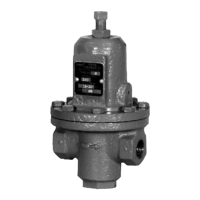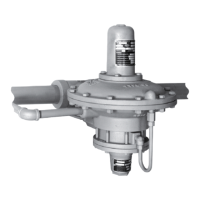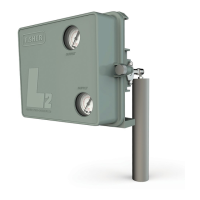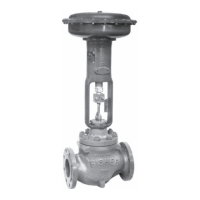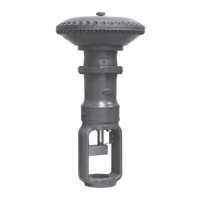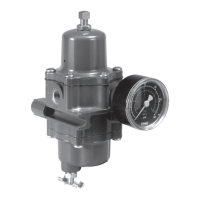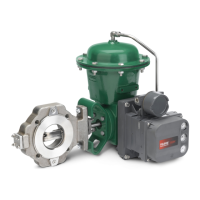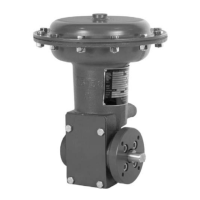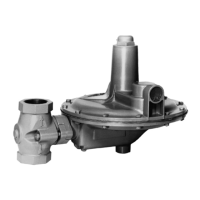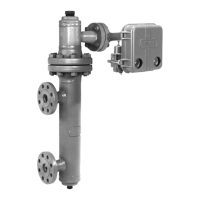Type 92S
3
Description
The Type 92S pressure-reducing regulator for steam
service includes either a Type 6492H, 6492HT, or
6492L pilot (Figure 1). Both pilots have a friction-
reducing bellows seal on the stem, and offer pressure-
setting adjustment plus sensitivity to downstream
pressure changes.
These pilots are available in either a standard version
with a drilled spring case vent, or an optional version
with a tapped spring case vent and a sealed adjusting
screw for pressure-loading or on-off service. A Fisher
®
67 or 1301 Series regulator or 670 Series panel-
mounted regulator may be used to load the pilot of a
version for pressure-loading service, while a solenoid
valve may be used on the pilot of a version for on-off
service. A Type 6492HM (or 6492HTM) safety override
pilot is available for the Type 92S. The Type 6492H (or
6492HT) pilot is used in a series installation with the
Type 6492HM (or 6492HTM) safety override
pilot installed on the upstream control valve. The
Type 6492HM (or 6492HTM) safety override pilot
senses pressure downstream of the second valve, and
prevents pressure from rising above safe operating
pressure in the event the downstream valve fails. This
system is approved by ASME B31.1-1989, 122.14.2.A,
and can replace an ASME safety valve when vent
piping is not practical and upstream steam pressure
does not exceed 400 psig (27,6 bar). Local codes
and standards may require approval by an appropriate
authority prior to installation.
!
WARNING
The Type 92S safety overide system
does not provide positive shut-off in
dead end service. It is intended for
large distribution systems where steam
leakage will condense before steam
pressure builds-up. Downstream piping
and components must be rated for
maximum upstream steam pressure for
dead end service. Failure to do so could
cause personal injury or death.
Principle of Operation
Pilot supply pressure is piped from the main valve inlet
(Figure 3) to the pilot inlet connection. Downstream
pressure registers on the main valve pistons through the
downstream control line and then on the pilot diaphragm.
When increased downstream demand lowers the
downstream pressure to a valve below the setting of the
pilot control spring, this spring forces the pilot valve plug
open to increase the loading pressure on the main valve
pistons. At the same time, the increased demand lowers
the downstream pressure on the main valve piston(s).
This opens the main valve plug, increasing ow to the
downstream system to satisfy the increased demand and
to restore downstream pressure to the setting of the pilot
control spring.
Decreased downstream demand increases the
downstream pressure registered on the pilot diaphragm.
The increased pressure overcomes the force of the pilot
control spring and allows the pilot valve plug spring to
close the pilot valve plug. As the pilot valve plug closes,
excess loading pressure bleeds to the downstream
system through the pilot bleed restriction. At the same
time, decreased downstream demand increases the
downstream pressure registered on the main valve
piston(s). This allows the main valve spring to close the
main valve plug, reducing ow to the downstream system
in response to the decreased demand.
With a pressure-loaded or on-off pilot, the operation is the
same as for a standard pilot except that the pilot control
spring force on the pilot valve plug is aided by pneumatic
pressure from the loading device or solenoid valve.
Safety Override Pilot Principle of Operation
Once placed in operation, the upstream Type 6492H
(or 6492HT) pilot senses the intermediate pressure
between both valves, and the Type 6492HM (or
6492HTM) pilot senses downstream pressure of
the second valve. As demand for ow increases,
intermediate pressure will fall causing the Type 6492H
(or 6492HT) pilot to open. As the Type 6492H pilot
valve opens, loading pressure to the main valve
increases, opening the main valve.
The Type 6492HM (or 6492HTM) safety override pilot
remains open because its setpoint is above the setpoint
of the downstream valve. In the unlikely event that the
downstream valve fails open, downstream pressure
will rise above the downstream valve’s setpoint. This
pressure is sensed by the Type 6492HM (or 6492HTM)
safety override pilot. As downstream pressure
increases the safety override pilot closes, reducing
loading pressure to the main valve, which positions
the main valve to maintain downstream pressure as
specied per ASME Boiler and Pressure Vessel Code,
section VIII.
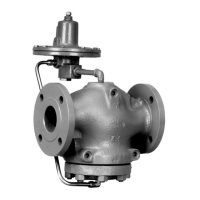
